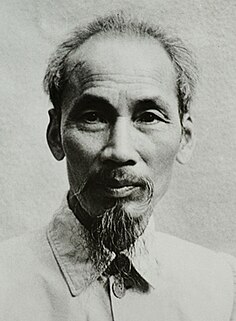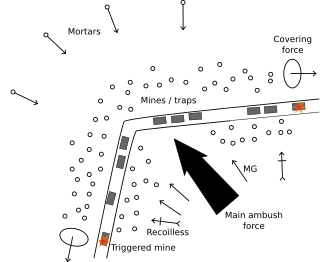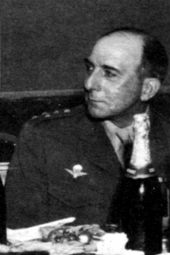 W
WThe 1916 Cochinchina uprising was a series of defiant protests and attempted revolts in February against the French colonisation of southern Vietnam, which had been the colony of Cochinchina since 1867.
 W
W1940—1946 in French Indochina focuses on events that happened in French Indochina during and after World War II and which influenced the eventual decision for military intervention by the United States in the Vietnam War. French Indochina in the 1940s was divided into five protectorates: Cambodia, Laos, Tonkin, Annam, and Cochinchina. The latter three made up Vietnam. In 1940, the French controlled 23 million Vietnamese with 12,000 French soldiers, about 40,000 Vietnamese soldiers, and the Sûreté, a powerful police force. At that time, the U.S. had little interest in Vietnam or French Indochina as a whole. Fewer than 100 Americans, mostly missionaries, lived in Vietnam and U.S. government representation consisted of one consul resident in Saigon.
 W
W1947–1950 in French Indochina focuses on events influencing the eventual decision for military intervention by the United States in the First Indochina War. In 1947, France still ruled Indochina as a colonial power, conceding little real political power to Vietnamese nationalists. French Indochina was divided into five protectorates: Cambodia, Laos, Tonkin, Annam, and Cochinchina. The latter three made up Vietnam.
 W
WThe Geneva Conference, intended to settle outstanding issues resulting from the Korean War and the First Indochina War, was a conference involving several nations that took place in Geneva, Switzerland, from April 26 to July 20, 1954. The part of the conference on the Korean question ended without adopting any declarations or proposals, so is generally considered less relevant. The Geneva Accords that dealt with the dismantling of French Indochina proved to have long-lasting repercussions, however. The crumbling of the French Empire in Southeast Asia led to the formation of the states of the Democratic Republic of Vietnam, the State of Vietnam, the Kingdom of Cambodia and the Kingdom of Laos.
 W
WOperation Adolphe a military operation by the French Army that took place during the First Indochina War, commencing in April 1953. It was the last of several operations that spring, concluding before the monsoon season made campaigning difficult until the commencement of Operation Camargue in July.
 W
WThe August Revolution, also known as the August General Uprising, was a revolution launched by Ho Chi Minh's Việt Minh against French and the Japanese Empire colonial rule in Vietnam, on August 14, 1945.
 W
WOperation Brochet took place during the French Indochina War, between August and October, 1953. A combined arms operation, Brochet involved 18 battalions of the French Expeditionary and Vietnamese National Armies fighting against the 42nd and 50th Viet Minh Regiments, fighting in the southern reaches of the Red River Delta near Tonkin in North Vietnam. The 1st and 2nd Parachute Battalions of the French Foreign Legion (BEP), and the 1st and 3rd Colonial Parachute Battalions (BPC) took part, as did forces of the Vietnamese National Army. Their objective was to sweep the Delta and remove Viet Minh influence.
 W
WOperation Camargue was one of the largest operations by the French Far East Expeditionary Corps and Vietnamese National Army in the First Indochina War. It took place from 28 July until 10 August 1953. French armored platoons, airborne units and troops delivered by landing craft to the coast of central Annam, modern-day Vietnam, attempted to sweep forces of the communist Viet Minh from the critical Route One.
 W
WThe Cần Vương movement was a large-scale Vietnamese insurgency between 1885 and 1889 against French colonial rule. Its objective was to expel the French and install the boy emperor Hàm Nghi as the leader of an independent Vietnam. The movement lacked a coherent national structure and consisted mainly of regional leaders who attacked French troops in their own provinces. The movement initially prospered as there were only a few French garrisons in Annam, but failed after the French recovered from the surprise of the insurgency and poured troops into Annam from bases in Tonkin and Cochinchina. The insurrection in Annam spread and flourished in 1886, reached its climax the following year and gradually faded out by 1889.
 W
WThe Battle of Cao Bằng was an ongoing campaign in northern Indochina during the First Indochina War, between the French Far East Expeditionary Corps and the Việt Minh, which began in October 1947 and culminated on September 3, 1949. Since the start of the conflict, Việt Minh troops had ambushed French convoys along the Vietnam–China border from the Gulf of Tonkin on a 147-mile route to a French garrison at Cao Bằng, known as Route Colonial 4, or RC4. Repeated ambushes led to repeated French operations of increasing strength to reopen the road, including a costly mission by the Foreign Legion in February 1948. On July 25, 1948, the Cao Bằng encampment was itself attacked and held out for three days with two companies defending against two battalions of Việt Minh. A further 28 ambushes took place in 1948.
 W
WThe Battle of the Day River took place between late May and early June 1951, around the Day River Delta in the Gulf of Tonkin. Part of the First Indochina War, the battle was the first conventional campaign of Võ Nguyên Giáp, and saw his Việt Minh People's Army of Vietnam (VPA) forces tackle the Catholic-dominated region of the Delta in order to break its resistance to Việt Minh infiltration. On the back of two defeats at similar ventures through March and April that year, Giap led three divisions in a pattern of guerrilla and diversion attacks on Ninh Bình, Nam Định, Phủ Lý and Phat Diem beginning on May 28 which saw the destruction of commando François, a naval commando.
 W
WCurrent Vietnamese historians considers that Vietnam has had a total of three declarations of independence:The poem Nam quốc sơn hà was written in 1077 by Lý Thường Kiệt and recited next to the defense line of the Như Nguyệt river, originally with the reason to incentive the spirit of the soldiers. Bình Ngô đại cáo was written by Nguyễn Trãi to speak in the name of Bình Định vương Lê Lợi in the Đinh Mùi year (1427), announcing the pacification of the Ming army, regaining the national independence, establishing the Later Lê Dynasty. The Proclamation of Independence was written by Hồ Chí Minh and announced at Ba Đình Square, Hanoi, on September 2, 1945, declared independence from Japan and France, founding the Democratic Republic of Vietnam.
 W
WViệt Minh was a national independence coalition formed at Pác Bó by Hồ Chí Minh on May 19, 1941. The Việt Nam Độc Lập Đồng Minh Hội had previously formed in Nanjing, China, at some point between August 1935 and early 1936 when Vietnamese nationalist parties formed an anti-imperialist united front. This organization soon lapsed into inactivity, only to be revived by the Indochinese Communist Party (ICP) and Hồ Chí Minh in 1941. The Việt Minh established itself as the only organized anti-French and anti-Japanese resistance group. The Việt Minh initially formed to seek independence for Vietnam from the French Empire. The United States supported France. When the Japanese occupation began, the Việt Minh opposed Japan with support from the United States and the Republic of China. After World War II, the Việt Minh opposed the re-occupation of Vietnam by France, resulting in the Indochina War, and later opposed South Vietnam and the United States in the Vietnam War. The political leader and founder of Việt Minh was Hồ Chí Minh. The military leadership was under the command of Võ Nguyên Giáp. Other founders were Lê Duẩn and Phạm Văn Đồng.
 W
WĐèo Văn Long was the French leader of the Autonomous Tai Federation of Northwestern Tonkin in post-war French Indochina.
 W
WThe Battle of Dien Bien Phu was a climactic confrontation of the First Indochina War that took place between 13 March and 7 May 1954. It was fought between the French Union's French Far East Expeditionary Corps and Viet Minh communist revolutionaries.
 W
WThe Empire of Vietnam was a short-lived puppet state of Imperial Japan governing the former French protectorates of Annam and Tonkin between March 11 and August 23, 1945.
 W
WThe First Indochina War began in French Indochina on December 19, 1946, and lasted until July 20, 1954. Fighting between French forces and their Việt Minh opponents in the south dated from September 1945. The conflict pitted a range of forces, including the French Union's French Far East Expeditionary Corps, led by France and supported by Bảo Đại's Vietnamese National Army against the Việt Minh, led by Hồ Chí Minh and the People's Army of Vietnam led by Võ Nguyên Giáp. Most of the fighting took place in Tonkin in northern Vietnam, although the conflict engulfed the entire country and also extended into the neighboring French Indochina protectorates of Laos and Cambodia.
 W
WThe Haiphong Incident or the Haiphong Massacre occurred on November 23, 1946, when the French cruiser Suffren bombarded the Vietnamese coastal city of Haiphong, killing some 6,000 Vietnamese people. The incident, also known as the Shelling of Haiphong, is thought of as the first armed clash in a series of events that would lead to the Battle of Hanoi on December 19, 1946, and with it the official outbreak of the First Indochina War.
 W
WThe Poisoning at Hanoi Citadel was a poisoning plot which occurred in 1908 when a group of Vietnamese indigenous tirailleurs attempted to poison the entire French colonial army's garrison in the Citadel of Hanoi. The aim of the plot was to neutralize the French garrison and make way for Hoang Hoa Tham's rebel army to capture Hanoi. The plot was disclosed, and then was suppressed by the French.
 W
WOn December 19, 1946, Viet Minh soldiers detonated explosives in Hanoi, and the ensuing battle, known as the Battle of Hanoi marked the opening salvo of the First Indochina War.
 W
WOperation Hirondelle took place during the First Indochina War in July 1953. It was an airborne raid on Viet Minh supply depots near Lạng Sơn, involving parachute units of the French Army and Vietnamese National Army. Raids near the junction of Route Coloniale 4 and Route Coloniale 1 revealed supply caches hidden in caves, which were photographed and destroyed.
 W
WHoàng Cao Khải was a viceroy of Tonkin, the northernmost of the three parts of Vietnam under French colonial rule. He is best known for his role in helping the French authorities to hunt down Phan Đình Phùng, the leading Vietnamese revolutionary of the time.
 W
WOperation Mouette was an operation in 1953 by the French Army in Northern Vietnam during the First Indochina War. It was launched on October 15 in an attempt to locate and destroy Viet-Minh Chu Luc troops operating under the command of Võ Nguyên Giáp around the area of Phu Nho Quan, south of the Red River Delta. Following the establishment of a French camp in the area, various troops were dispatched to engage the Viet-Minh forces. The operation was ended and the French withdrew by November 7, claiming approximately 1,000 enemy combatants killed, twice as many wounded, and 181 captured as well as a substantial quantity of weapons and ammunition.
 W
WThe Battle of Muong Khoua, also called Upper Laos campaign by the Vietminh, took place between April 13 and May 18, 1953, in northern Laos during the French Indochina War. A garrison of a dozen French and 300 Laotian troops occupied a fortified outpost in the hills above the village of Muong Khoua, across the border from Điện Biên Phủ. Muong Khoua was among the last French outposts in northern Laos following the decision of the French High Command to string several isolated garrisons through the region in order to buy time to fortify the major Laotian cities against Việt Minh attack.
 W
WThe Nationalist Party of Greater Vietnam, often known simply as Đại Việt or DVQDD, was a nationalist and anti-communist political party and militant organisation that was active in Vietnam in the 20th century. The party continues to be active outside of Vietnam, with the goal of a multi-party democratic government for the country.
 W
WThe uprising of the Nghệ-Tĩnh soviets was the series of uprisings, strikes and demonstrations in 1930 and 1931 by Vietnamese peasants, workers, and intellectuals against the colonial French regime, the mandarinate, and landlords. Nghệ-Tĩnh is a compound name for the two central provinces, Nghệ An and Hà Tĩnh, where the revolt mainly took place. Demonstrations expressed the general anger against French colonial policies such as heavy taxation and state monopolies on certain goods, as well as the corruption and perceived unfairness of local notables and mandarins. Demonstrators, while violent, were armed with little more than basic farm weapons, and were brutally suppressed by the overwhelming military strength of the French. The revolt waned by the second half of 1931 due to famine and suppression.
 W
WThe Nguyễn dynasty was the last Vietnamese dynasty, which ruled Vietnam largely independently from 1802 to 1883. During its existence, the empire expanded into modern-day southern Vietnam, Cambodia, and Laos through a continuation of the centuries-long Nam tiến and Siamese–Vietnamese wars. After 1883, the Nguyễn emperors ruled nominally as heads of state of the French protectorates of Annam and Tonkin until the final months of WWII; they later nominally ruled over the Empire of Vietnam until the Japanese surrender.
 W
WPhú Riềng Đỏ or the Red Phú Riềng was a communist-instigated strike that took place in Michelin's Thuân-Loï rubber plantation near Phú Riềng in the Biên Hòa Province of Cochinchina on 4 February 1930. Most of the plantation labourers were peasants from Tonkin and Annam driven by poverty to seek livelihood in southern Vietnam. Working and living conditions on the plantations, however, were harsh and this situation was capitalised by the communists to launch the strike. Although the strike lasted only about a week, the unfolding of events at Phú Riềng Đỏ was significant as it served as a harbinger for important tactical and strategic considerations for other communist-led uprisings that followed later in the year. Hence, while the communists may not seem to have achieved much from Phú Riềng Đỏ, it actually offered them some valuable first lessons in their anti-colonial struggle.
 W
WThe Thái Nguyên uprising in 1917 has been described as the "largest and most destructive" anti-colonial rebellion in French Indochina between the Pacification of Tonkin in the 1880s and the Nghe-Tinh Revolt of 1930–31. On 30 August 1917, an eclectic band of political prisoners, common criminals and insubordinate prison guards mutinied at the Thai Nguyen Penitentiary, the largest one in the region. The rebels came from over thirty provinces and according to estimates, involved at some point roughly 300 civilians, 200 ex-prisoners and 130 prison guards.
 W
WThe Tonkin Free School was a short-lived but historically significant educational institution in Hanoi that aimed to reform Vietnamese society under the French protectorate during the beginning of the 20th century.
 W
WThe Viet Cong, also known as the National Liberation Front of Southern Vietnam or NLF, was an armed communist political revolutionary organization in South Vietnam and Cambodia. Its military force, the Liberation Army of South Vietnam (LASV), fought against the United States and South Vietnamese governments during the Vietnam War, eventually emerging on the winning side. The LASV had both guerrilla and regular army units, as well as a network of cadres who organized peasants in the territory the Viet Cong controlled. During the war, communist insurgents and anti-war activists claimed that the Viet Cong was an insurgency indigenous to the South, while the U.S. and South Vietnamese governments portrayed the group as a tool of North Vietnam.
 W
WThe Việt Nam Quang phục Hội was a nationalist republican militant revolutionary organization of Vietnam that was active in the 1910s, under the leadership of Phan Bội Châu and Prince Cường Để. Formed in March 1912, its objective was to overthrow French colonial rule in Vietnam and establish a democratic republic. The organization failed to gain momentum, crippled by arrests of its members.
 W
WThe Việt Nam Quốc Dân Đảng or the Nationalist Party of Vietnam, abbreviated VNQDĐ or Việt Quốc, was a nationalist and moderate socialist political party that sought independence from French colonial rule in Vietnam during the early 20th century. Its origins lie in the mid-1920s, when a group of young Hanoi-based intellectuals began publishing revolutionary material. In 1927, after the publishing house failed because of French harassment and censorship, the VNQDD was formed under the leadership of Nguyễn Thái Học. Modelling itself on the Kuomintang of Nationalist China the VNQDD gained a following among northerners, particularly teachers and intellectuals. The party, which was less successful among peasants and industrial workers, was organised in small clandestine cells.
 W
WAt the outbreak of World War I, Vietnam was under French protectorate and part of French Indochina. While seeking to maximize the use of Indochina's natural resources and manpower to fight the war, France cracked down all patriotic movements in Vietnam. As the country remained a member of the French Empire, many Vietnamese fought later in the conflict.
 W
WThe Yên Bái mutiny was an uprising of Vietnamese soldiers in the French colonial army on 10 February 1930 in collaboration with civilian supporters who were members of the Việt Nam Quốc Dân Đảng.